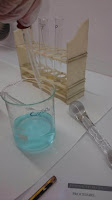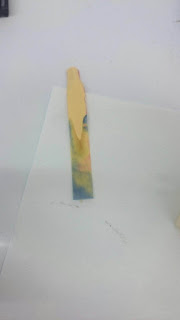Biuret's test is a chemical test used concentration.
For detecting the presence of peptide bonds. Polypeptides as proteins, are chains of amino acids link together by peptide bonds.
A peptide bond can be broken by hydrolysis (the adding water). In organisms, protein molecules called enzymes facilitate the process.
OBJECTIVES:
1. Identify peptide bonds.
2. Compare protein concentration in different foods.
PROCEDURE:
DILUTE THE PROTEIN
1. Add 100ml of distilled water to each 250ml beaker. Lebel them with M(milk), EW (egg white), EY (yolk), P (potato) and RM (rice milk)
2. Separate the egg white and the yolk in another beaker.
3. Smash the potato in a mortar and add some amount of the smashed potato to the P beaker.
PREPARE THE SAMPLES:
4. Add 10ml of a dispersion of each food (M, RM, EY, EW and P) to the indicate beaker. Calculate the final concentration. All the groups will use the same dispersion from the beakers.
5. Prepare 6 test tubes (cleand and dry) and lebel (M, RM, EY, EW and P). Add 2ml of the every food dilution of each beaker.
6. Add 2ml of 20% NaOH dissolution.
7. Shake gently and add 5 drops of CuCO4 in each tube. Allow the mixture 5 minutes.
8. Note any colout change. Remember that proteins will turn solution pink or purple.
9. Compare the test tubes.
---------> CuCO4

----------> NaOH
Observations and results:
RESULTS:
Positive: M, EW( more proteins that the EY) and EY (have a lot of lipids)
Negative: P, RM
- The concentration of proteins change the colour.
- The sodium hydroxide change the pH (basic)
- The copper change the colour.
- The food that has more proteins is the milk.































